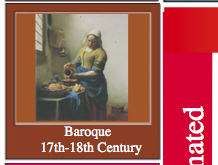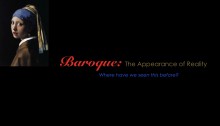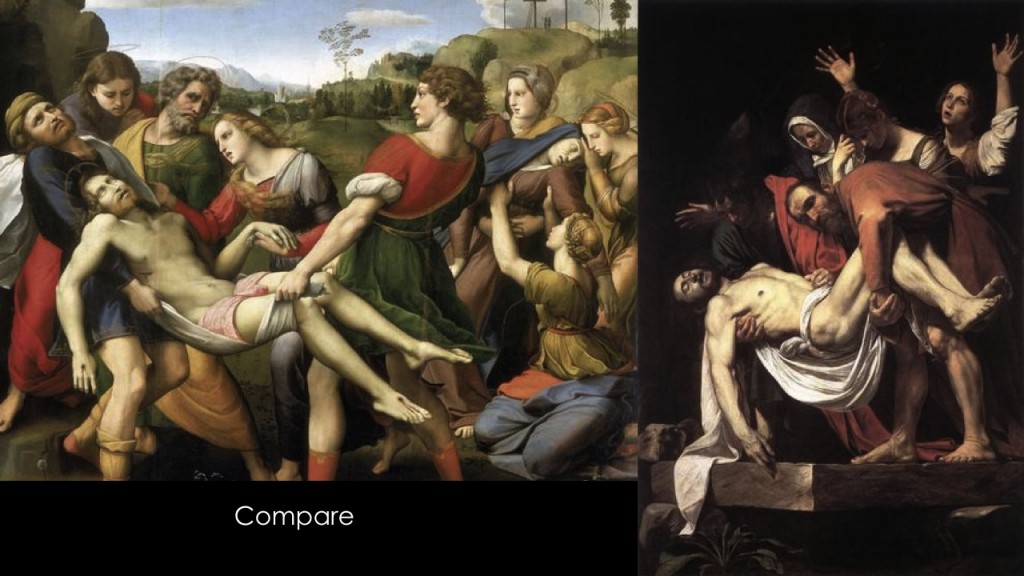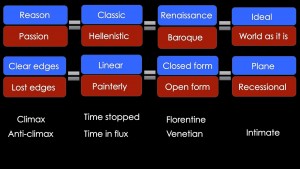
The fifth session of the “Art is Us” art history class for Spring 2015 was held on Thursday, April 16. Paintings from the Renaissance and Baroque were compared, and parallels to Greek Classic and Hellenistic art were identified. Underlying human qualities of reason and passion are associated with these two archetypal movements. Examples of Baroque and Northern Renaissance art were presented and analyzed. There are new comparison and tribes homework assignments.
Homework assignment
Following the pattern established in previous weeks, there are two homework assignments for next week: compare two artworks, and a new Tribes game.
[gview file=”https://dicknelsoncolor.com/wp-content/uploads/2015/04/TitianManet.pdf”]
[gview file=”https://dicknelsoncolor.com/wp-content/uploads/2015/04/Tribes6.pdf”]
Class recap – some key ideas
Here is the answer sheet to last week’s Tribes game. Notice the chronological progression, and the parallels to what we’re seeing in art history.
[gview file=”https://dicknelsoncolor.com/wp-content/uploads/2015/04/SpaceTribesANS.pdf”]
Comparison homework discussion
The homework assignment was to compare two paintings, Raphael’s Lamentation of Christ and Caravaggio’s Deposition of Christ.
Dick asked the groups for their general statements for the comparison. This one captured the idea: “Although the religious theme and the subjects are the same, and although they were both made in a man-dominated era, they are two different paintings; one of Classicism, inspired from Greek Classic but with new discoveries of perspective, the other one Baroque, inspired from Greek Hellenistic with a new understanding of composition and light.” The whole idea of these assignments is to see what you can bring to a new situation from what we’ve already done in the previous four weeks. Dick is trying to be very redundant on this, every week, reinforcing what we’ve already learned. He said, “What I really like about that general statement is the recognition that there’s really nothing terribly new here. If we trace the lineage of the Raphael, it has a very comfortable place in the Greek Classic… High Renaissance is to Greek Classic as Baroque is to Hellenistic Greek… This general statement gets to the roots: we can see the world as we’d like it to be, or we can see the world as it really is. These are major ideas: reason versus passion.”
The artist has many choices in how a piece takes shape. These choices are influenced by the artist’s beliefs and their times. Composition, for example, is a choice, an outer layer of the onion. Driving that choice, at the core, are the beliefs, values, and world-view of the artist. An artist of the High Renaissance valued man’s capability to reason and decide. The orderly plane composition, closed forms, pure colors, and idealized figures convey the story in a rational way. The Baroque artist, on the other hand, was trying to bring Christianity (in scenes such as our comparison pieces) to the heart, not the mind, of the viewer. Thus, he chose devices to enhance the emotional impact of the artwork on the viewer and invite participation: a recessional composition, inviting you into the action instead of placing you in the audience like planar composition; people with realistic appearances and flaws; lost details that your brain has to fill in; intimate lighting that sets a mood. To Dick, this is what great art is all about: “How you paint is related to what you believe.”
Reason-Passion
Art historian Heinrich Wölfflin articulated five principles in art; Dick is focusing on three of them in this course. They are polarities, that occur repeatedly together through the history of art.
- Linear / Painterly
- Plane / Recession
- Closed form / Open form
These align with the universal human characteristics of reason and passion, head and heart. Other characteristics can be observed that also correspond with these, in repeating cycles in art history, as laid out in the slides below.
Periods and qualities associated with reason are Classical Greek, Renaissance, ideal, clear edges, linear, closed form, plane composition, climax, time stopped, Florentine.
Periods and qualities associated with passion are Hellenistic Greek, Baroque, world as it is, lost edges, painterly, open form, recessional composition, anti-climax, time in flux, Venetian.
Class materials
Lecture and slideshow: Baroque, Northern Renaissance, Rococo
- Title slide: Baroque
- Comparison assignment, see above
- Contrasting High Renaissance and Baroque pieces and their characteristics. The painterly Baroque style is closer to how we really see the world. We don’t see detail; we fill it in. Reaching the viewer emotionally takes a deep understanding of the tools available, to make the right choices and execute them to achieve the desired effect.
- Diagramming a Baroque painting – how it draws us in and involves us emotionally
- Sculptures of David from the Renaissance and Baroque have qualities similar to paintings of their times
- Parallel polarities of reason and passion as exemplified by the High Renaissance and the Baroque
- Reason / Passion intro
- Reason / Passion game
- Analyzing a Baroque painting – identifying distinguishing characteristics
- Velázquez – Spanish Baroque
- Velázquez captured a fleeting moment and a casual scene on a grand scale
- The Northern Renaissance: Van Eyck’s Arnolfini Wedding
- Dick is morphological in his approach to art history, interested in form and what it tells us. Many art historians take an iconographic approach, interested in the painting’s symbolism. This painting is full of symbolism, and also shows how accurately the painter was observing his world.
- Hans Holbein’s Northern Renaissance portrait of Henry VIII is contrasted with Rembrandt’s Baroque self-portrait
- Holbein’s Henry VIII
- Rembrandt’s self-portrait. Wölfflin sums up Rembrandt’s painterly technique, saying he paints “the glance, not the eye” and “the breath, not the lips.” But he had to have a detailed understanding of the underlying structure in order to suggest real detail with globs of paint.
- Even a line drawing can have painterly qualities. Photographic replication is a skill, but has little to do with art.
- Rembrandt’s Night Watch was unconventional and got him into trouble.
- A contemporary commentary, which may have been staged or Photoshopped.
- Rembrandt’s self-portraits capture a momentary quality.
- Franz Hals: “rascally”
- While these paintings look casual, pulling off that painterly, slashed, sketchy effect demands mastery.
- Vermeer. No one would have thought of doing a simple “genre scene” like this in the Renaissance. It wasn’t what they were interested in.
- Vermeer used modern optics to aid his accuracy. He was good at suggesting detail without having to replicate it exactly.
- Rubens’ subject, motion, and interpretation have more action and drama than Vermeer’s works, but are still recognizably Baroque.
- Rubens was the “man of the hour” in his time. Notice the difference in quality of the flesh of these nudes, from the stone-like flesh of the Renaissance.
- Royal patrons had time and money to indulge in fantasy.
- Baroque art started to branch out and become more diverse.
- We see the classical style making a comeback.
- A preview of the next turn of the wheel.
The 2009 version:
Audio files
Part 1, Comparison homework and slides 1-12 (58:18)
Part 2, Lecture on the Baroque, slides 13-30 (1:25:54)



